How to wash tarpaulin fish pond is a critical question every new fish farmer or intended fish farmer would be asking. This is because it is a critical aspect of maintaining a healthy fish pond, especially a tarpaulin fishpond. This guide will walk you through the steps to effectively clean your tarpaulin fish pond, ensuring a healthy environment for your fish.
Introduction
Tarpaulin fish ponds have become increasingly popular due to their cost-effectiveness, flexibility, mobility, and ease of setup. However, like any fish pond, they require regular maintenance to prevent the build-up of algae, debris, and harmful bacteria. Learning how to wash tarpaulin fish pond would not only promote a healthier habitat for your fish but also extend the life of the tarpaulin material.
Why Regular Cleaning is Important
– Health of the Fish: Regular cleaning prevents the accumulation of harmful bacteria and algae that can affect the health of your fish.
– Longevity of the Pond: Proper maintenance extends the lifespan of the tarpaulin, saving costs on replacements.
– Aesthetic Appeal: A clean pond is more visually appealing and can enhance the overall environment of your fish farming area.
Preparation for Cleaning
Tools and Materials Needed
Before starting the cleaning process, gather the necessary tools and materials:
– Cleaning brushes (soft and hard bristle)
– Non-toxic cleaning agents (vinegar)
– Buckets or hose for water
– Protective gloves
– Fish net (for temporarily moving the fish)
– Empty containers or a secondary pond (for holding the fish)
– Scrubbing pads
– Safety goggles
Steps to Prepare the Pond
1. Stop Feeding the Fish: Cease feeding the fish 24 hours before cleaning to reduce waste in the pond.
2. Prepare a Temporary Habitat: Set up a secondary pond or containers with the same water conditions to temporarily house your fish during the cleaning process.
3. Gently Remove the Fish: Using a fish net, carefully transfer the fish to the temporary habitat to avoid stressing them. It applies where there are fish in the pond.
Draining the Pond
To clean the pond effectively, you must first drain it completely. As you drain, start washing the edges removing the debris and algae as the water goes down. This is because it becomes easier to wash when it’s still wet. But it becomes difficult to wash once the dirt is dried on it.
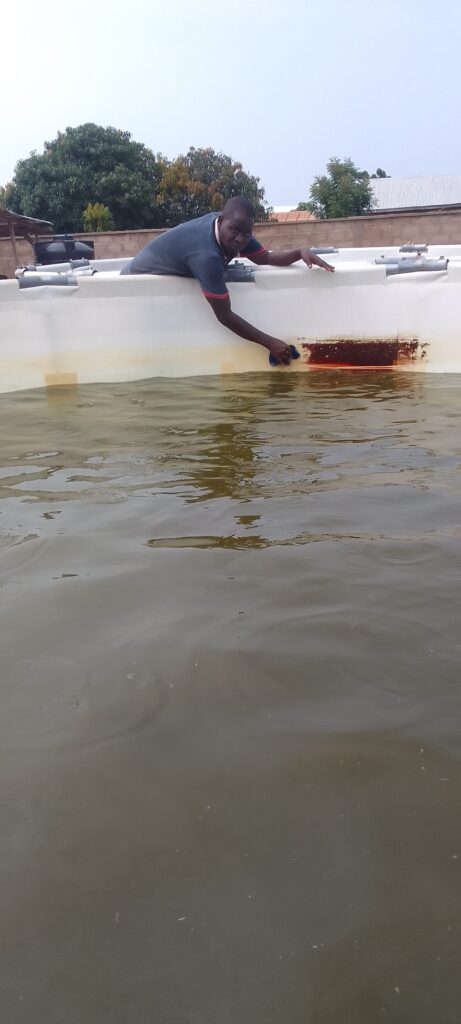
washing edges of dirt as I drain water in the fishpond
How to Drain the Pond
To effectively learn how to wash tarpaulin fish pond, you need to consider the following
1. Turn Off Pumps and Filters: Ensure all pumps and filtration systems are turned off. This is necessary since most of those pumps are submersible. Submersible pumps are best to work inside water so draining the water to expose the pumps can spoil them.
2. Use a Siphon or Pump: Employ a siphon or a submersible pump to drain the water from the pond. Make sure to direct the water to a suitable drainage area. You can simply use one of the aeration or filtration pumps and not necessarily use a new pump for the draining.
3. Remove Remaining Water: Use buckets or a wet/dry vacuum to remove any remaining water from the bottom of the pond. A well-designed fish pond must not drain all the water through the outlet. This is because, in case you are not around, all the water can accidentally move out leaving the fish to die. But once the small water remains in the bottom, the fish can survive in there for a while. So you will need buckets, foams, and rags to drain and clean up the remaining water.
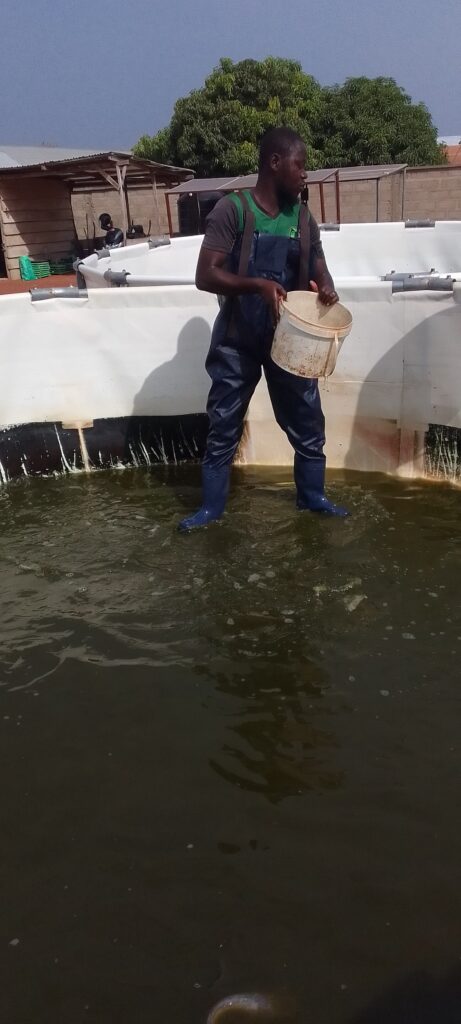
removing remaining water in pond before washing
Cleaning the Pond
Scrubbing the Tarpaulin
1. Apply Cleaning Solution: Mix a dash of vinegar with water in a bucket. Avoid using harsh chemicals as they can leave residues harmful to the fish. This includes heavy soap.
2. Scrub the Walls and Floor: Use soft-bristle brushes for gentle scrubbing and hard-bristle brushes for tougher stains. Pay special attention to corners and areas with visible algae or debris build-up.
3. Rinse Thoroughly: After scrubbing, rinse the pond thoroughly with clean water to remove all vinegar residues.
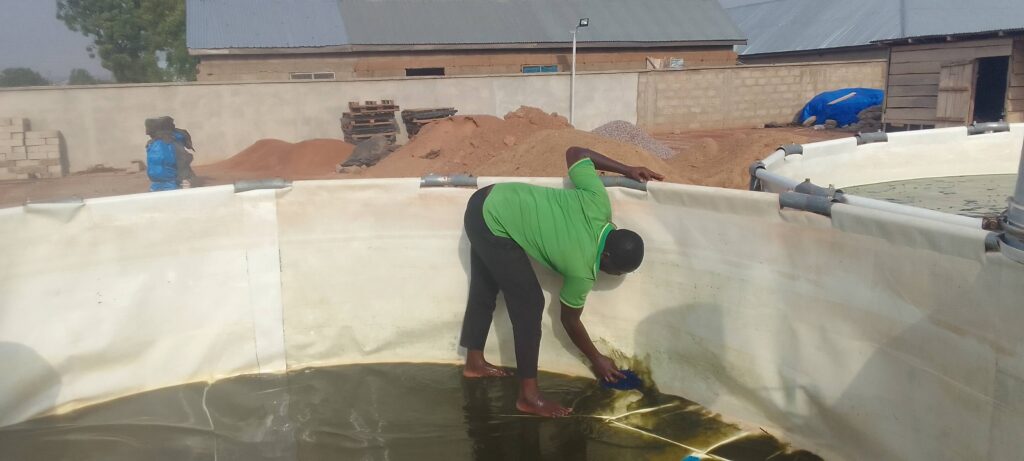
washing fishpond with sponge
Addressing Algae and Bacterial Build-up
1. Use a Scrubbing Pad: For stubborn algae, use a scrubbing pad with a bit of the cleaning solution.
2. Rinse and Repeat: Rinse the areas after scrubbing and repeat the process if necessary until all algae are removed.
Inspecting the Pond
Once the cleaning is done, you need to inspect the pond for any damages or wear and tear.
Checking for Leaks and Tears
1. Inspect Seams and Corners: you need to carefully check all seams and corners of the tarpaulin for any signs of wear or small tears.
2. Repair Damages: Use a tarpaulin repair kit to fix any minor tears or leaks. For significant damages, consider replacing the damaged section or consulting a professional.
Ensuring Cleanliness
1. Final Rinse: Give the pond a final rinse with clean water to ensure all cleaning agents are completely washed away.
2. Allow to Dry: Let the pond dry completely before refilling it with water. This helps to prevent any mold or mildew from developing.
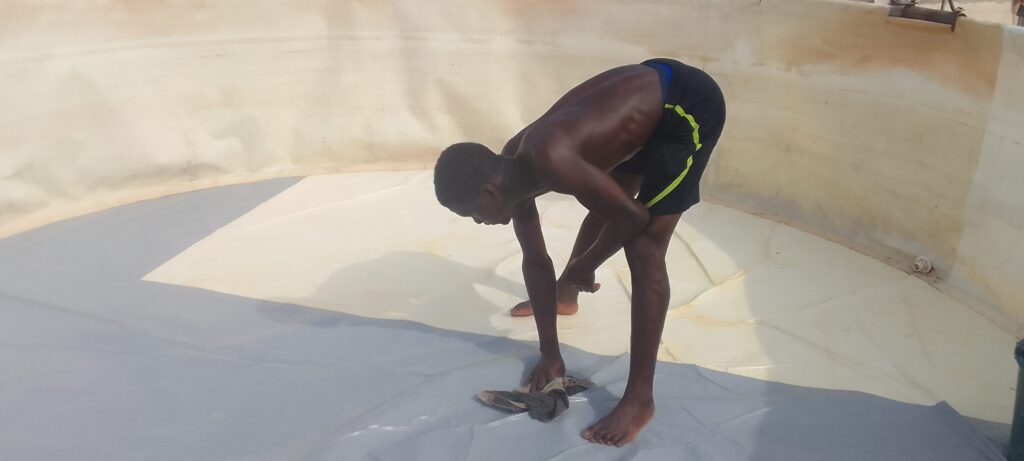
recleaning the fishpond
Refilling the Pond
Preparing the Water
1. Clean Source of Water: Use clean, dechlorinated water to refill the pond. If using tap water, let it sit for 24 hours to allow chlorine to dissipate, or use a water conditioner. But once you are using the right water source, you do not need to allow the water for 24 hours.
2. Check Water Parameters: Ensure the water’s pH level, temperature, and other parameters match the needs of your fish species. This can be achieved using the right test kits
Refilling Process
1. Salt bathe: you have to use a salt solution to salt rub the pond before filling in the water.
2. Slowly Refill the Pond: Use a hose or bucket to slowly refill the pond. This helps in preventing the stirring up of any residual debris.
2. Monitor Water Levels: Keep an eye on the water levels to ensure even filling. If you underfill it, the fish will not be comfortable and the water will not also cover the submersible pumps. And if you also overfill it, the fish can jump out. So you need to strike a balance between the two.
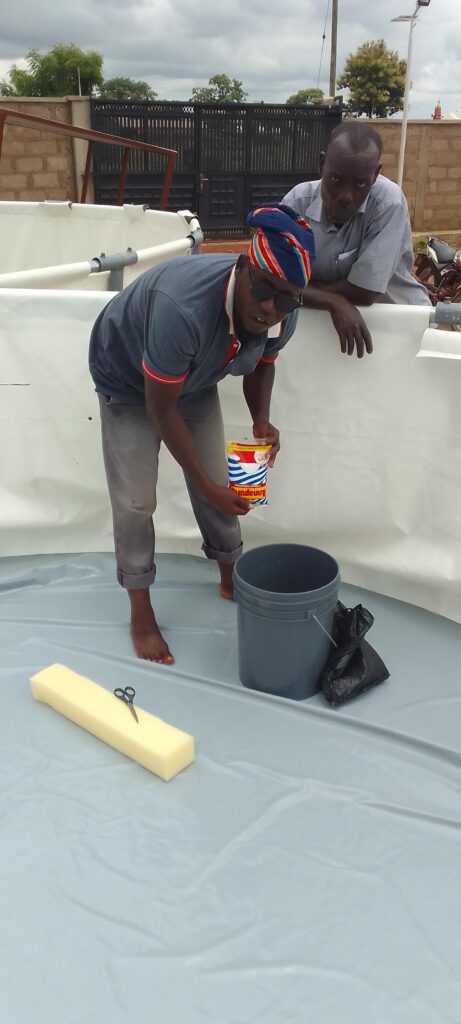
salt bathing fish pond
Reintroducing the Fish
Acclimating the Fish
1. Temperature Adjustment: Make sure the water temperature in the pond matches the temperature of the temporary habitat.
2. Slow Introduction: Gradually introduce the fish back into the pond to minimize stress. Float the containers in the pond for 15-20 minutes to equalize temperatures before releasing the fish.
Monitoring After Reintroduction
1. Observe the Fish: After reintroducing the fish, observe them for any signs of stress or unusual behavior. And if you notice any unusual behavior, you need to act fast and provide remedies.
2. Resume Feeding: Wait for a few hours before resuming feeding to allow the fish to settle back into their clean environment.
Regular Maintenance Tips
Weekly Checks
– Water Quality: Test the water quality regularly for pH level, ammonia, nitrate, and nitrite levels.
– Debris Removal: You need to always remove any visible debris from the pond to prevent build-up.
Monthly Maintenance
– Partial Water Change: Perform a partial water change (about 20-30%) to maintain water quality.
– Inspect Equipment: Check pumps, filters, and other equipment to ensure they are functioning correctly.
Seasonal Deep Cleaning
– Complete Cleaning: Perform a complete cleaning of the pond every six months to a year, following the steps outlined in this guide.
– Post Harvesting Cleaning: Always clean the pond right after harvesting your fish using the above methods. To learn more about how to harvest fish in a pond, you may check out this POST
Conclusion
Learning how to wash tarpaulin fish pond is essential for the health and well-being of your fish. Regular cleaning and maintenance not only provide a healthy environment for the fish but also extend the life of your tarpaulin pond.
By following the steps detailed in this guide, you can ensure your fish pond remains clean, safe, and productive. Remember, a little effort in regular upkeep goes a long way in ensuring the success of your fish farming endeavors.
I recommend you check out my post 15 Best Aquaculture Courses to Maximize Your Fish Production.





